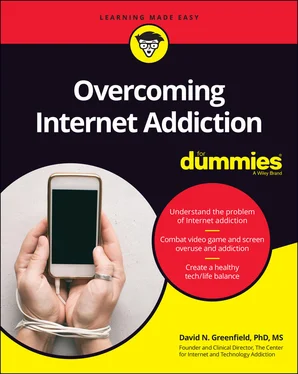Obviously, during the COVID pandemic, use of screens became a virtual lifeline for school and social connection. This increased reliance on screens has made balanced use even more complex, but it doesn’t change the fact that there are many ways to live with less screen time, including spending less time on smartphones.
The Internet and all the screens connected to it are not inherently problematic, but rather serve to be a potent distractor from less stimulating activities, such as school, sleep, self-care, work, chores, and so on, and there is a tendency to find previously motivating pursuits less rewarding due to reward deficiency syndrome. This topic is discussed in more detail in Chapters 2, 4, and 10.
In addition, while computers and the Internet are often presented as a necessary tool for learning, you rarely hear about them being used as a popular tool for cheating, even though it is a common practice. As reported by Common Sense Media in 2019, teens are using their smartphones to “cheat” on homework, tests, or other assignments.
Exploring Other Factors That Contribute to Addiction in Children and Teens
The interaction between the brain and the Internet is only one aspect of developing an addiction to screen technologies. Numerous other factors may also contribute, such as those in the following sections. (A major factor — children’s and teens’ lack of experience and natural consequences — is covered earlier in this chapter.)
The constant presence of smartphones
Screens connected to the Internet (especially smartphones) are the norm for how youth socialize, interact, and spend significant amounts of their discretionary time. On average, teenagers spend five to six hours a day using social media, Snapchatting, Instagramming, texting, and scrolling on their smartphones — frequently sacrificing sleep, academics, and physical activity to do so. Smartphones and other screens have risen from being tools of productivity and utility to being a peer-based requirement for living. They are no longer simply devices, but have become a required, stimulating, and addictive possession. Indeed, you would be hard-pressed to find a teen (or tween) without a smartphone in the United States.
According to Statistica in 2020, about 100 million children and younger adults have smartphones, with nearly 6 million under age 11 having one. Another important point, according to the Pew Research Center, is that about 56 percent of parents feel that they themselves are using their smartphone too much, and about 36 percent feel they are on social media too much. These are adults we are talking about who have fully developed brains, and they feel they are not able to control their smartphone or social media use. This gives you some perspective on how potent these technologies really are; considering this data, it makes sense that our children, tweens, teens, and young adults have a guarded prognosis in being able to manage these technologies effectively.
Smartphones have become more like clothing accessories than communication devices, and it’s only a matter of time before people are literally wearing them as opposed to holding them. Because a smartphone is seen as more than a device, it’s important to have the newest and best options (even though they essentially do the same things). There is often excitement around apps and phone capabilities offered on new models that are quite expensive, and the smartphone and cellular industry spends millions on marketing, promoting the need to have the latest and greatest device.
As I mention earlier in this chapter, the good news is that your kids may be less likely to want you to buy them a car, because data show that, on average, teens are obtaining their driver’s licenses much later than previous generations. Why go anywhere when anywhere comes to them?
The “need” for technology
The developers of the Internet viewed the web as a utilitarian tool. They never envisioned it as entertainment or a detour from life. The Internet has now almost morphed into having an identity of its own. It’s no longer a tool used to accomplish something, but rather it’s equivalent to what a car used to be to a teen or young adult. I’ve heard others refer to the Internet as essentially a virtual mall, and kids now hang out in cyberspace instead of physically. Some children likely feel more at home on their device than with people. Talking on the phone is done. Conversation has changed. It has been replaced by chatting, texting, IMing, DMing, snapping, commenting, liking, following, and Instagramming.
 When teens use the word “talk,” they don’t mean verbal communication; rather, they mean texting, chatting, or snapping. It’s likely that your child’s ability to communicate verbally is either underdeveloped or has atrophied to the point where they may need some skills development. Words have been abbreviated to the point where a few letters or symbols (emoji) are used instead of complete words, sentences, and thoughts. Everything is streamlined and cut short. Although this may or not be equivalent to more in-depth forms of communication, it may be this generation’s form of social and cultural differentiation. Screens have become integral to personal expression, and they seem to be augmentations to help express aspects of their identity — such as personal appearance, fashion, politics, friends, or interests.
When teens use the word “talk,” they don’t mean verbal communication; rather, they mean texting, chatting, or snapping. It’s likely that your child’s ability to communicate verbally is either underdeveloped or has atrophied to the point where they may need some skills development. Words have been abbreviated to the point where a few letters or symbols (emoji) are used instead of complete words, sentences, and thoughts. Everything is streamlined and cut short. Although this may or not be equivalent to more in-depth forms of communication, it may be this generation’s form of social and cultural differentiation. Screens have become integral to personal expression, and they seem to be augmentations to help express aspects of their identity — such as personal appearance, fashion, politics, friends, or interests.
The growth of social alienation
 Growing levels of social alienation, seemingly fed by overuse of Internet technologies, place children, tweens, teens, and young adults at an increased risk of developing addictions and other mental health issues. Recent data show markedly greater levels of psychiatric issues, such as depression, suicidality, identity concerns, and social alienation, that not surprisingly correlate with the rapid adoption of the smartphone over the last 13 years. Social media use appears correlated with reduced social empathy and has increased and promulgated cyberbullying and trolling to concerning degrees.
Growing levels of social alienation, seemingly fed by overuse of Internet technologies, place children, tweens, teens, and young adults at an increased risk of developing addictions and other mental health issues. Recent data show markedly greater levels of psychiatric issues, such as depression, suicidality, identity concerns, and social alienation, that not surprisingly correlate with the rapid adoption of the smartphone over the last 13 years. Social media use appears correlated with reduced social empathy and has increased and promulgated cyberbullying and trolling to concerning degrees.
Video games and screen distractions may often fill a void and provide a means of engagement and feelings of acceptance when the user lacks the self-confidence or social skills comfort. Internet activities are easy ways to avoid boredom and unpleasant tasks, and to connect with peers. This is not all bad, and many good things can and do come from this process. Excelling on a video game affords an enhanced level of accomplishment, which a parent cannot ignore; often, your child feels a sense of mastery and success in their gaming, relative to other aspects of their life. You may hear your child tell you how good they are at the game and how highly they are ranked or appreciated by fellow gamers. As a parent, it’s important for you to understand and acknowledge how much their sense of self may be enhanced by gaming.
 The goal is to help expand your child’s level of competence and self-efficacy beyond the game or their screen activities. Initially, this may seem like a tug of war, but ultimately, it’s a necessary part of the recovery and growth process. Part 3has more information on diagnosing and treating Internet addiction.
The goal is to help expand your child’s level of competence and self-efficacy beyond the game or their screen activities. Initially, this may seem like a tug of war, but ultimately, it’s a necessary part of the recovery and growth process. Part 3has more information on diagnosing and treating Internet addiction.
Читать дальше

 When teens use the word “talk,” they don’t mean verbal communication; rather, they mean texting, chatting, or snapping. It’s likely that your child’s ability to communicate verbally is either underdeveloped or has atrophied to the point where they may need some skills development. Words have been abbreviated to the point where a few letters or symbols (emoji) are used instead of complete words, sentences, and thoughts. Everything is streamlined and cut short. Although this may or not be equivalent to more in-depth forms of communication, it may be this generation’s form of social and cultural differentiation. Screens have become integral to personal expression, and they seem to be augmentations to help express aspects of their identity — such as personal appearance, fashion, politics, friends, or interests.
When teens use the word “talk,” they don’t mean verbal communication; rather, they mean texting, chatting, or snapping. It’s likely that your child’s ability to communicate verbally is either underdeveloped or has atrophied to the point where they may need some skills development. Words have been abbreviated to the point where a few letters or symbols (emoji) are used instead of complete words, sentences, and thoughts. Everything is streamlined and cut short. Although this may or not be equivalent to more in-depth forms of communication, it may be this generation’s form of social and cultural differentiation. Screens have become integral to personal expression, and they seem to be augmentations to help express aspects of their identity — such as personal appearance, fashion, politics, friends, or interests. The goal is to help expand your child’s level of competence and self-efficacy beyond the game or their screen activities. Initially, this may seem like a tug of war, but ultimately, it’s a necessary part of the recovery and growth process. Part 3has more information on diagnosing and treating Internet addiction.
The goal is to help expand your child’s level of competence and self-efficacy beyond the game or their screen activities. Initially, this may seem like a tug of war, but ultimately, it’s a necessary part of the recovery and growth process. Part 3has more information on diagnosing and treating Internet addiction.










